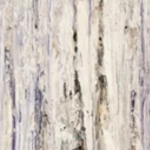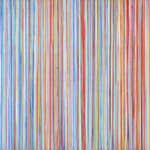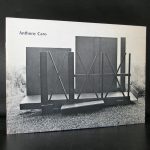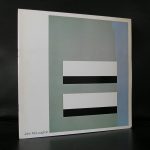
It must have been in 1979. Because at that time i started to take an interest in more serious abstract art and one of the first galleries i visited was a local one. The ARTLINE gallery represented some nice artists. Among them Tomas Rajlich of whom i first saw some great paintings and an american artist….Larry Poons. I liked his vertical rectangular shaped canvasses. It was clear to me that part of the composition was by coincidence. From top to bottom he “painted with acrylic. Great abstract expressionist art and i believe the ARtline gallery was later continued as Seasons galery . The Seasons gallery presented aroudn 2000 a series of paintings by Eric de Nie.
left Poons / right de Nie
The paintings/vertical drip paintings were in technique similar to the ones i had seen twenty years earlier, but with a much lighter touch and more precise. The video shows the process of painting. The result great paintings that stand on their own.
De Nie has a very personal method to compose his paintings. At first he chooses three to five, sometimes even six, colors of (diluted) paint that he drips on the canvas one by one. He arranges a pattern of stripes by an almost mathematical system, ‘out of an agreement with myself’ as he calls it. After using all of the colors the sharp lines get faded out with half-wet pencils in different sizes, causing the colors to blend and resulting in a richer pallet of colors. For the second and following layers the artist uses the same colors again, this time liberated from the earlier restriction of the system as De Nie reacts to the consequences of his previous actions in a more coincidental way. The process results in a universe of layers, that seduces the spectator to wander around in the painting endlessly.
The artist developed this method in the last fifteen years. Growing unto more refinement at first to subsequently (partly) throw that overboard by wiping the lines away, the style of De Nie evolved over the years. Nevertheless his paintings show a very characteristic manner. The motives of vibrant lines are hard to see through and make you wonder if they are either randomly arranged or organized according to an ingenious pattern. A mystery that is caused by the combination of the tightness of the systematic starting point, the dynamic appearance of the partly faded stripes and the more reactive way of painting in the later phase.
A major inspiration to De Nie is music, especially experimental jazz and composed contemporary music. In the past some of the titles of his work referred to pieces of music by his favorite composers, such as Giacinto Scelsi, Morton Feldman and György Ligeti. Also in performances, in which he painted while listening to music, the reference is clear. In this kind of music De Nie ‘hears a feeling’ that suits his way of painting. The aspect of increasing and fading is strongly present in his recent paintings, as the concentration of lines expands or the colors are more bright at one point and less dense or intense in the next area. Opposite to the work he made before 2005, which showed a more all-over way of painting with less accents, his latest work shows more range in rhythm and emphasis, providing an experience of space and time to the spectator. De Nie himself likes to certify his work as lyrical: ‘By that I mean the reminding of a lyrical feeling by looking at my work. My paintings are pieces of music in color.’
www.ftn-books.com has some Eric de Nie titles available.




























































